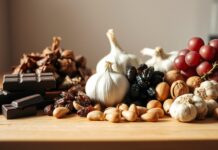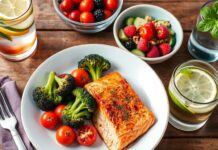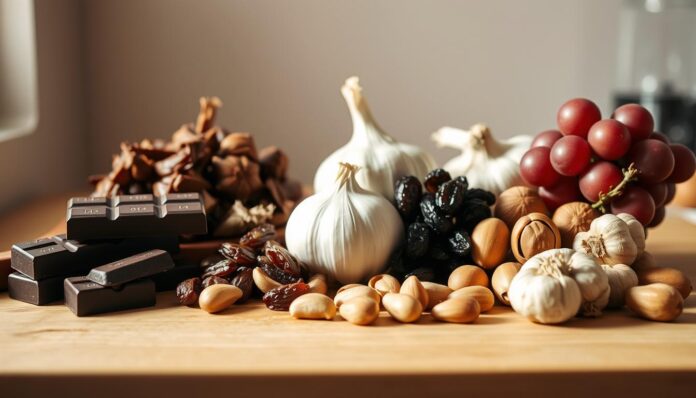As a pet owner, you want to keep your pet safe and healthy. It’s important to know which foods are toxic to them. Many foods we eat can be harmful to pets, causing serious health problems or even death.
Pet owners often accidentally feed their pets harmful foods. This guide aims to teach you about pet safety and list toxic foods. Knowing which foods to avoid can help keep your pets safe and healthy.
Key Takeaways
- Be aware of common household foods that can be toxic to pets
- plug into a reliable toxic food list to ensure pet safety
- Understand the importance of pet safety and its impact on your pet’s health
- Take preventive measures to avoid accidental poisoning
- Stay informed about the latest research on toxic foods and pet safety
- Consult with your veterinarian for personalized advice on pet safety and toxic food list
- Prioritize your pet’s health by creating a pet-safe kitchen environment
Understanding Pet Food Toxicity: Why It Matters
As a pet owner, you want your furry friend to be safe and healthy. It’s important to know about pet food toxicity. Many pet owners don’t know the dangers of certain foods, which is why learning about pet poisoning prevention is crucial. Knowing the signs of toxicity and what to do in an emergency is key.
Some people think all human foods are safe for pets. But that’s not true. Foods like chocolate and caffeine can harm pets. It’s important to know which foods are toxic and how to prevent accidents.
To keep your pet safe, you need to know about food dangers. Here are some important points:
- Be aware of toxic foods, such as chocolate and caffeine products
- Keep human food out of reach of your pet
- Monitor your pet’s behavior and watch for signs of toxicity
By following these steps, you can prevent pet poisoning and keep your pet healthy and happy. Remember, knowing is power when it comes to pet poisoning prevention. Stay informed and take steps to protect your pet.
Common Toxic Foods for Pets in Your Kitchen
As a pet owner, knowing which foods are toxic is key. Foods like grapes, onions, garlic, and chocolate can harm your pets. These foods might seem safe, but they can lead to serious health problems.
It’s important to spot the dangers in your kitchen. For example, onions and garlic can harm your pet’s red blood cells. Grapes and raisins can cause kidney failure. Chocolate, with its theobromine, is also toxic to pets, mainly in large amounts.
To protect your pets, keep these foods away from them. Here are some foods to watch out for:
- Grapes and raisins
- Onions and garlic
- Chocolate
- Caffeine products
Knowing the toxic food list and keeping these foods out of reach helps. This way, you can make your kitchen safe for your pets. Always choose caution when it comes to your pet’s health and safety.
The Danger of Chocolate and Caffeine Products
As a pet owner, knowing about chocolate toxicity and caffeine toxicity is crucial. These substances can harm pets because they are stimulants. Chocolate and caffeine have toxic compounds that can cause symptoms ranging from mild to severe.
For chocolate toxicity, the symptoms depend on the chocolate type and amount. Dark and baking chocolate are more dangerous than milk chocolate. The smaller the pet, the more it’s at risk. Caffeine toxicity can also be harmful, leading to a fast heart rate, high blood pressure, and seizures.
To keep your pets safe from chocolate toxicity and caffeine toxicity, keep these substances away. Here are important tips:
- Keep chocolate and caffeine products in secure locations
- Watch your pet’s behavior for signs of toxicity, like vomiting, diarrhea, and a fast heart rate
- Get vet help right away if you think your pet has eaten chocolate or caffeine
Knowing about chocolate toxicity and caffeine toxicity helps protect your pets. Always choose caution for your pet’s health and safety.
Fruits and Vegetables That Can Harm Your Pet
As a pet owner, keeping your pet safe is key. Fruits and veggies are good for us, but some can harm pets. Items like avocados and mushrooms are dangerous if pets eat them. Knowing the toxic food list is important for your pet’s health.
It’s crucial to know which fruits and veggies to avoid. Here are a few examples:
- Grapes and raisins can cause kidney failure
- Onions and garlic can lead to anemia
- Rhubarb has toxic compounds that can cause vomiting and diarrhea
Knowing about these dangers helps protect your pet. Always check the toxic food list before adding new foods. This ensures pet safety.
Creating a safe kitchen for pets needs careful attention. Being mindful of the foods you have at home is important. This helps prevent accidents and keeps your pet healthy.
Hidden Dangers in Processed Human Foods
As a pet owner, you are key in pet poisoning prevention. Knowing which foods are toxic to pets is important. Foods like xylitol, found in sugar-free products, can be harmful.
It’s vital to check food labels to keep your pet safe. Some foods, even if safe for humans, can be dangerous for pets. Always be careful about what you feed your pet.
To keep your pet safe, know the dangers in human foods. Here are some tips:
- Always read food labels carefully
- Avoid giving your pet table scraps or human food
- Keep toxic substances out of reach
By following these tips and being careful, you can keep your pet safe and healthy.
Emergency Steps When Your Pet Eats Toxic Foods
As a responsible pet owner, being ready for emergencies is key. This is true, more so when it comes to emergency pet care. If your pet eats something toxic, you must act fast to keep them safe. The first thing to do is call a vet or a pet poison hotline for help.
Some important steps to take include:
- Stay calm and act quickly
- Give as much info as you can about the toxic food
- Do what the vet or hotline tells you to do
In some cases, your pet needs to see a vet right away. It’s important to have a plan ready. This includes a list of emergency numbers and a vet’s office nearby. By being ready and acting fast, you can keep your pet safe and get them the care they need.
Creating a Pet-Safe Kitchen Environment
To keep your kitchen safe for pets, follow a few easy steps. First, store toxic foods in high cabinets where pets can’t get them. This stops them from eating harmful things by accident. You can also have a special area for pet-friendly foods like healthy treats and snacks.
It’s also important to handle food waste carefully. Always throw away food scraps and leftovers right, and keep trash cans closed. This keeps pets away from harmful foods. Use pet-safe cleaning products to clean your kitchen to avoid toxic residue.
- Store cleaning supplies and chemicals safely
- Keep electrical cords and appliances out of reach
- Use a pet gate or barrier to block off parts of the kitchen
By following these tips, you can make your kitchen a safe and healthy place for pets. Always check thetoxic food list to make sure you’re not storing anything harmful where pets can get it.
Conclusion: Keeping Your Pets Safe and Healthy
To keep your pets safe and healthy, you need to learn and stay alert. This guide has shown you how to spot toxic foods for pets in your kitchen. It also taught you what to do if your pet eats something bad.
By using the tips from this guide, you can lower the chance of your pet eating something harmful. It’s important to check your kitchen often for dangers. Keeping harmful foods away from your pet is also crucial.
Now, you know how to make your home safe for your pet. This means they can live a happy and long life with you. Always be careful and listen to your gut when it comes to your pet’s safety.
FAQ
What are the most common toxic foods for pets?
Grapes, onions, garlic, chocolate, and caffeine products are toxic to pets. Also, avocados and mushrooms are harmful.
Why is it important to understand pet food toxicity?
Many pet owners don’t know about food dangers. This can lead to poisoning. Knowing about pet food toxicity helps keep pets safe.
How can chocolate and caffeine harm my pet?
Chocolate and caffeine can be very harmful. They can cause vomiting, diarrhea, and heart problems. In severe cases, they can even be fatal.
What should I do if my pet accidentally eats a toxic food?
If your pet eats something toxic, act fast. Call your vet or a pet poison hotline. They will tell you what to do next.
How can I create a pet-safe kitchen environment?
Keep toxic foods out of reach by storing them high up. Use safe cleaning products. Also, be careful with food waste. These steps help keep your pet safe.
For more health tips and wellness advice, explore Negony.com and discover valuable insights to help you live a healthier, happier life.



























